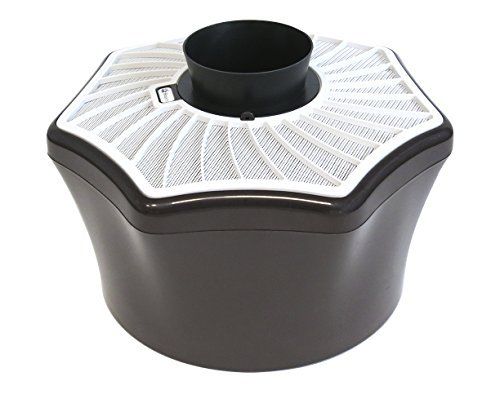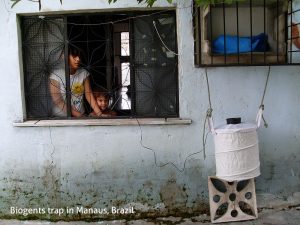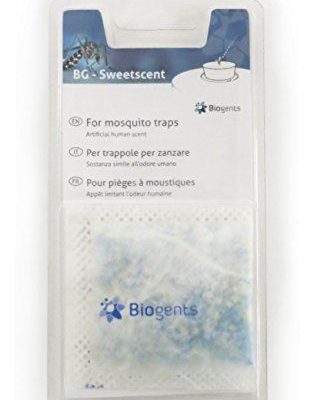Descripción
Biogents: Trampas para mosquitos con tasa de captura superior
Las trampas para mosquitos Biogents es el resultado de más de 16 años de investigación académica sobre el comportamiento de los mosquitos. Por lo tanto se desarrolló un nuevo tipo de trampa altamente eficaz. Se usa en modelos diversos para diferentes regiones y especies de mosquitos. La efectividad superior de las trampas par mosquitos Biogents ha sido científicamente comprobada por investigadores de todo el mundo: Haga clic aquí para descargar una lista de estudios científicos con trampas Biogents. Con más de 70.000 trampas para mosquitos vendidas, Biogents es el líder del mercado de las trampas para mosquitos tigres (mosquitos tigre asiáticos, Aedes albopictus y mosquitos del dengue o de la fiebre amarilla, Aedes aegypti).
Las trampas Biogents para mosquitos pueden controlar poblaciones de mosquitos localmente y reducir significativamente las tasas de picaduras e incomodidad. También se utilizan como trampas de vigilancia altamente efectivas.
Trampas para mosquitos para los propietarios de viviendas domesticas de uso inmediato
- robustas y resistentes
- fácil de configurar
Base científica y publicaciónes
Las trampas de mosquitos Biogents fueron inventadas por los científicos que han estado haciendo investigaciónes sobre el comportamiento de los mosquitos y otros insectos hematófagos durante más de 16 años. Aplicaciónes útiles y un número de patentes son el resultado de la investigación en profundidad fundamental en la Universidad de Ratisbona. Aparatos y trampas originalmente construidos para colegas investigadores y especialistas en el campo han sido evolucionados hasta convertirse en productos completamente desarrollados dentro de un corto período de tiempo.
El BG-Sentinel se convirtió en una de las principales trampas para el control de mosquitos tigre y otras especies dentro de unos pocos años después de su invención en 2004. Un número cada vez mayor de publicaciónes científicas independientes revisadas por expertos apoyan una prueba impresionante del uso amplio de la trampa y sus tasas de captura extraordinarias.
Una colección de publicaciónes
 Lista de estudios con trampas Biogents (Inglés) >
Lista de estudios con trampas Biogents (Inglés) >
 Lista de publicaciónes científicas de nuestros investigadores (Inglés) >
Lista de publicaciónes científicas de nuestros investigadores (Inglés) >
Publicaciónes seleccionadas (Inglés)
Englbrecht et al., 2015: Evaluation of BG-Sentinel trap as a management tool to reduce Aedes albopictus nuisance in an urban enviroment in Italy
Since its introduction and establishment in Italy during the early 1990s, the Asian tiger mosquito, Aedes albopictus, has spread over large parts of Italy and other Mediterranean countries. Aedes albopictus is both a nuisance and a competent vector for various arthropod-borne pathogens. Although efficient traps for Ae. albopictus exist and are used for population monitoring, their use as a control tool has not yet been studied. We evaluated Biogents BG-Sentinel mosquito traps, used with the BG-Lure, as control tools in northern Italy. The trial was performed as a controlled experiment in which 3 intervention sites, equipped with 7 or 8 BG-Sentinel traps each, were matched with 3 comparable control sites. Trap density ranged from 1 trap per 150 m2 to 1 per 350 m2. Mosquito populations were monitored at both the intervention and control sites with weekly human landing collections (HLC) and ovitraps. Between 64% and 87% fewer Ae. albopictus individuals were collected by HLC at the intervention sites with the BG-Sentinel mosquito traps, as compared to the untreated control sites. These results indicate that the sustained use and proper placement of efficient mosquito traps can significantly reduce Ae. albopictus biting pressure.
Read more about the results in the publication:
Englbrecht, C., Gordon, S., Venturelli, C., Rose, A., and Geier, M. (2015). Evaluation of BG-Sentinel Trap as a Management Tool to Reduce Aedes albopictus Nuisance in an Urban Environment in Italy. Journal of the American Mosquito Control Association 31, 16–25.
 Download the publication >
Download the publication >
 Download flyer with summary of publication (page 2 of the flyer) >
Download flyer with summary of publication (page 2 of the flyer) >
Degener et al, 2014: Evaluation of the Effectiveness of Mass Trapping With BG-Sentinel Traps for Dengue Vector Control: A Cluster Randomized Controlled Trial in Manaus, Brazil
1400 households, 450 Biogents traps, uncounted dengue mosquitoes – a long-term study in Brazil
Regensburg 2014/03/27 – Dengue fever is widely distributed in Brazil and other tropical and subtropical regions and a constant threat to the local population. Dengue is mosquito-borne virus that infects up to 100 million people each year. Because there is no effective vaccine available, the only way to control the disease is by controlling the dengue mosquitoes. While the use of conventional insecticides is widespread, they have become increasingly ineffective due to insecticide resistance.
A new approach to control the mosquitoes could be the mosquito trap developed by Biogents. A large-scale study published in the Entomological Society of America’s Journal of Medical Entomology has demonstrated for the first time that these traps can also reduce the number of dengue mosquitoes (Aedes aegypti) in a broad urban area. The study co-financed by the world-bank was conducted over 18 months with more than 1400 households and 450 Biogents traps in Manaus, Brazil.
The result: „The study shows that the Biogents traps can significantly reduce the amount of adult female Aedes aegyptiespecially in the rainy season” says Prof. Eiras from the University Federal de Minas Gerais (Brazil). The number of dengue infections in the test areas also decreased. An additional advantage for household trap users was the Biogents traps also reduced numbers of the annoying and often numerous tropical house mosquito (Culex quinquefasciatus). Households that used the traps reported a noticeable reduction in the nuisance from mosquitoes. Additional studies will be required to investigate the effects of trapping on larger scales and during epidemics.
Publication:
Degener et al, 2014: Evaluation of the Effectiveness of Mass Trapping With BG-Sentinel Traps for Dengue Vector Control: A Cluster Randomized Controlled Trial in Manaus, Brazil, J. Med. Entomol. 51(2): 000Ð000 (2014); DOI: http://dx.doi.org/10.1603/ME13107
 PDF 2014/03/27 press release >
PDF 2014/03/27 press release >
 Download publication >
Download publication >
 Download a summary of the publication (page 1 of the flyer) >
Download a summary of the publication (page 1 of the flyer) >
Multiyear Surveillance for Aedes albopictus with Biogents Sentinel Trap Counts for Males and Species Composition of Other Mosquito Species
40 to 50 BGS traps were utilized during an intensive 5-year surveillance as part of an ‘Area-wide Management Program for the Asian Tiger Mosquito’ in NJ, USA. The results are now published. The authors say that the Biogents Sentinel (BGS) trap is a very effective tool to monitor adult populations of Aedes albopictus and that although BGS traps are becoming the gold standard instrument for Ae. albopictus surveillance, they can also be used to collect other important mosquito species, which can enhance existing vector surveillance programs.
Read more about the results in the publication:
Unlu I., Farajollahi A. (2014) Multiyear Surveillance for Aedes albopictus with Biogents Sentinel Trap Counts for Males and Species Composition of Other Mosquito Species. Journal of the American Mosquito Control Association, 30(2):122-125.
DOI: http://dx.doi.org/10.2987/14-6401.1
Comparison of 4 traps used for mosquito monitoring and surveillance programs: The BG-Sentinel trap is probably the best solution
Four different traps, Biogents Sentinel trap (BG trap), Heavy Duty Encephalitis Vector Survey trap (EVS trap), Centres for Disease Control miniature light trap (CDC trap) and Mosquito Magnet Patriot Mosquito trap (MM trap) were compared in a 4×4 latin square study. In the years 2012 and 2013, more than seventy 24-hour trap comparisons were conducted at ten different locations in northern and southern Germany, representing urban, forest and floodplain biotopes.
Conclusion: The autors say that the BG trap showed a significantly better or similar performance compared to the CDC, EVS or MM trap with regard to trapping efficacy for most common mosquito species in Germany, including diversity of mosquito species and number of mosquitoes per trapping period. Thus, they say, the BG trap is probably the best solution for general monitoring or surveillance programs of adult mosquitoes in Central Europe.
Read more about the results in the publication:
Lühken et al. (2014) Field evaluation of four widely used mosquito traps in Central Europe.Parasites & Vectors 2014, 7:268
doi:10.1186/1756-3305-7-268





Valoraciones
No hay valoraciones aún.